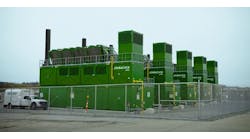Regional trucking and logistics company Pitt Ohio is deploying a renewable energy microgrid at a trucking terminal in Parma, Ohio.
Being built by WindStax and EnSync, the microgrid uses solar, wind power and battery-based energy storage to optimize on-site power and distribution for cost and reliability, based on Pitt Ohio’s needs and utility grid conditions.
Seven WindStax horizontal wind turbines line the entrance to a trucking terminal under construction in Parma Ohio. Photo courtesy of WindStax
Pitt Ohio describes itself as committed to clean energy and sustainability. Reliable and cost-effective electricity is critical to its day-to-day operations for lighting, powering fuel pumps, and for heating, cooling and ventilation. Reliability becomes even more crucial during grid outages, natural disasters or other emergencies given the role transportation hubs, such as the Parma terminal, play in disaster response. Outages also lead to lost productivity.
In addition to working in-sync with the utility grid, the microgrid will be able to operate autonomously, in island mode, and produce and distribute enough emissions-free electricity to serve all the Parma terminal’s electricity loads during grid outages, and then some.
Inside the Parma renewable energy microgrid
With 495 kW of solar PV, 48 kW of wind power and 730 kWh of lithium ion-based battery energy storage capacity, the Parma terminal microgrid will be able to produce electricity in excess of the facility’s typical needs in both grid-connected and island modes. That will enable Pitt Ohio to store surplus energy and sell and dispatch it to the utility grid.
The renewable energy microgrid is under construction with a spring 2019 completion target.
Pitt Ohio is purchasing the entire microgrid from WindStax, which contracted with EnSync to handle systems integration and communications, command and control. In addition, WindStax and EnSync will provide operations and maintenance services under a 25-year contract.
The manufacturer of small-scale, vertical wind turbines, WindStax is becoming increasingly involved in hybrid distributed energy and microgrid projects, and it’s working closely with EnSync in doing so.
The Parma project uses EnSync’s DC power bus-based Matrix Energy Management technology and its DER Flex IOE (Internet of Energy) power control software platform.
It’s about the DC power bus
Many renewable energy microgrid projects rely primarily on inverters to coordinate and manage energy production and distribution. EnSync takes a different approach, one that’s centers on its DC power bus, to integrate and optimize multple distributed energy resources (DERs).
“The Matrix platform allows for the simple integration of AC or DC assets to provide for AC or DC loads. Suffice it to say that if you’re using conventional inverter infrastructure it can be very difficult to integrate multiple DERS,” Dan Nordloh, EnSync Energy Systems’ executive vice president, told Microgrid Knowledge.
Rather than taking an inverter-based approach, the DC power bus architecture and Matrix control platform allows DERs “to do what they can do,” he said.
“DER Flex, the DC power bus and Matrix power control architecture ensures that we’re sourcing the least expensive, most reliable electrons from every available source in a way that serves all the Parma terminals loads and optimizes the microgrids’ overall performance. That could mean sourcing electricity from the grid, the battery energy storage system, the wind turbines or solar PV,” he said.
There’s a great deal of benefit associated with generating electricity from wind and solar on-site to produce a higher voltage DC distribution network to serve end-use loads, added a spokesperson for WindStax. On-site generation minimizes the energy lost when distributing energy over longer distances. In addition, energy losses converting AC to DC, as well as inverting DC to AC are avoided.
Other trucking center microgrids
The Parma terminal microgrid is the latest initiative by Pitt Ohio as it seeks to realize its clean energy and sustainability goals.
The trucking and transportation company also is working with the University of Pittsburgh’s Center for Energy and GRID Institute. Pitt Ohio and the university center have implemented a DC microgrid at a trucking and logistics center outside of Pittsburgh. As of May, the microgrid incorporated a 50-kW solar PV system, 5 kW of wind power and 70 kWh of battery-based energy storage.
A second project is being built at a Pitt Ohio Express trucking logistics center outside of Cleveland, Ohio.
Track news about renewable energy microgrid projects. Subscribe to the free Microgrid Knowledge newsletter.







